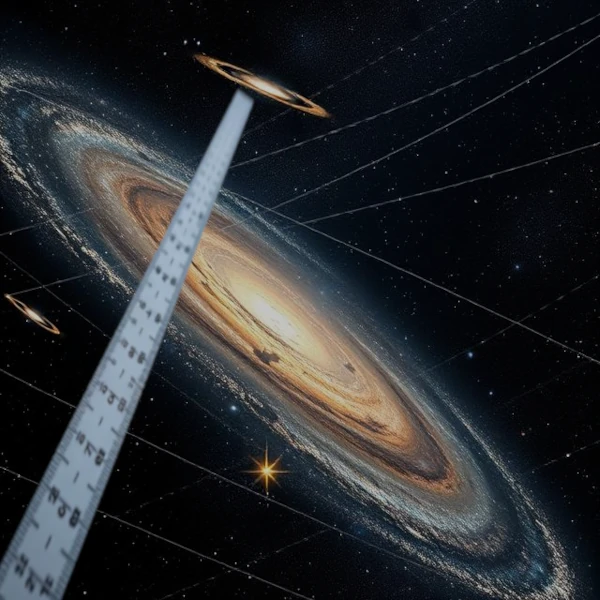
In 1929, Edwin Hubble provided the first observational evidence for the expansion of the Universe by establishing the relationship between the distance of galaxies and their recession velocity. This relationship, known as Hubble's law, is expressed by the formula v = H₀ × d, where v is the recession velocity, d is the distance, and H₀ is the Hubble constant.
In 1998, two independent teams studying Type Ia supernovae made a revolutionary discovery: the expansion of the Universe is not slowing down as expected, but accelerating. This observation, awarded the 2011 Nobel Prize in Physics, implies the existence of a repulsive energy, dubbed "dark energy", which makes up about 68% of the Universe's energy content.
| Component | Percentage | Effect on expansion | Nature |
|---|---|---|---|
| Dark energy | ~68% | Acceleration | Unknown, negative pressure |
| Dark matter | ~27% | Deceleration | Non-baryonic, gravitational interaction only |
| Ordinary matter | ~5% | Deceleration | Atoms, stars, galaxies |
The concept of "creating space" in the expanding Universe is subtle and often misunderstood. It is not about the appearance of new space from "nothing" in a philosophical sense, but about the increase in the proper distance between comoving points in spacetime.
N.B.:
Comoving points refer to fixed coordinates in the expanding Universe. A distant galaxy retains its comoving position, even though the distance separating us increases with the scale factor. In other words, it does not "move" locally but follows the expansion of the cosmic metric.
When we say that the Universe "creates space," we should not imagine the fabrication of a void, as if the Universe were producing some kind of invisible matter. In reality, what evolves is the geometry of the Universe, that is, the way distances are measured between two points.
In the language of physicists, the very structure of spacetime is dynamic: the coordinates of distant galaxies remain fixed (they are said to be comoving), but the "ruler" used to measure distances changes over time. So it is not a material "fabric" that is stretching, but the metric that evolves.
In other words, the Universe does not add volume like inflating a balloon with air; it recalculates what it means to be separated by a million light-years. What is "created" is neither void nor a mysterious substance, but a relative increase in distances between distant cosmic objects.
Saying that the Universe "creates space" is a figurative way of translating a mathematical reality. In cosmology, we do not manipulate a material fabric but a metric, that is, a formula that indicates how to calculate distances between two points in the Universe. When accelerated expansion is at play, it is this metric that changes over time.
Thus, it is not "space" as a substance that is multiplying, but the geometric relationship between points that is transforming. The Friedmann-Lemaître-Robertson-Walker (FLRW) metric provides the framework: it shows that the scale factor increases, which means that two comoving galaxies see their distance grow even if they are not moving locally.
This vocabulary is useful for popularization, but it is important to remember that it is a shortcut: what we are really describing is a dynamic evolution of the geometric equations of general relativity: \( G_{\mu\nu} + \Lambda g_{\mu\nu} = \frac{8 \pi G}{c^4} T_{\mu\nu} \)
In many illustrations, galaxies are shown moving further and further apart, as if they were actually traveling through pre-existing space. But in the context of general relativity, this is not how expansion should be understood. Distant galaxies do not "travel" through the cosmos; they maintain their position in the comoving grid, while it is this grid—the metric itself—that is measured differently over time. In other words, it is the metric itself that changes scale with time. It is not a substance that is deforming, but the rules of measurement (distances, intervals) that are stretching.
N.B.:
Very distant galaxies receding at speeds said to be "faster than light" do not violate special relativity, because they do not correspond to local motion but to the evolution of geometry itself.